Intel SSD 520 Review: Cherryville Brings Reliability to SandForce
by Anand Lal Shimpi on February 6, 2012 11:00 AM ESTRandom Read/Write Speed
The four corners of SSD performance are as follows: random read, random write, sequential read and sequential write speed. Random accesses are generally small in size, while sequential accesses tend to be larger and thus we have the four Iometer tests we use in all of our reviews.
Our first test writes 4KB in a completely random pattern over an 8GB space of the drive to simulate the sort of random access that you'd see on an OS drive (even this is more stressful than a normal desktop user would see). I perform three concurrent IOs and run the test for 3 minutes. The results reported are in average MB/s over the entire time. We use both standard pseudo randomly generated data for each write as well as fully random data to show you both the maximum and minimum performance offered by SandForce based drives in these tests. The average performance of SF drives will likely be somewhere in between the two values for each drive you see in the graphs. For an understanding of why this matters, read our original SandForce article.
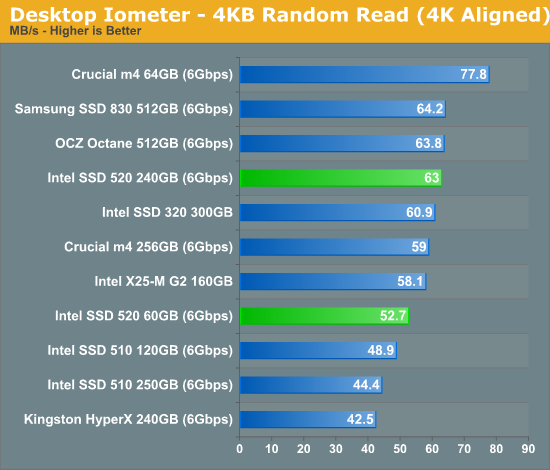
Random read performance seems to have topped out around 60MB/s for most drives and the 520 is no different here.
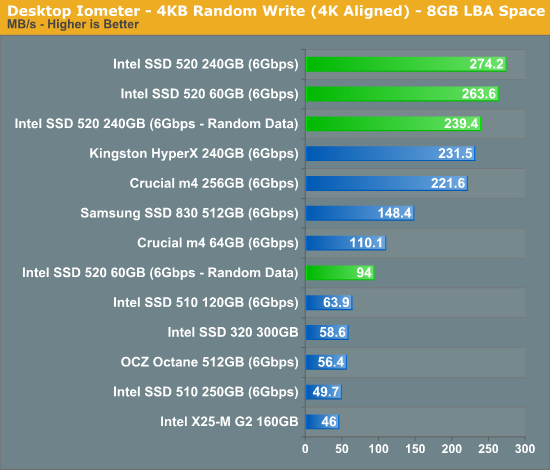
Random write performance, especially with highly compressible data sets the 520 performs beautifully - even outpacing the SF-2281 based Kingston HyperX.
Many of you have asked for random write performance at higher queue depths. What I have below is our 4KB random write test performed at a queue depth of 32 instead of 3. While the vast majority of desktop usage models experience queue depths of 0 - 5, higher depths are possible in heavy I/O (and multi-user) workloads:
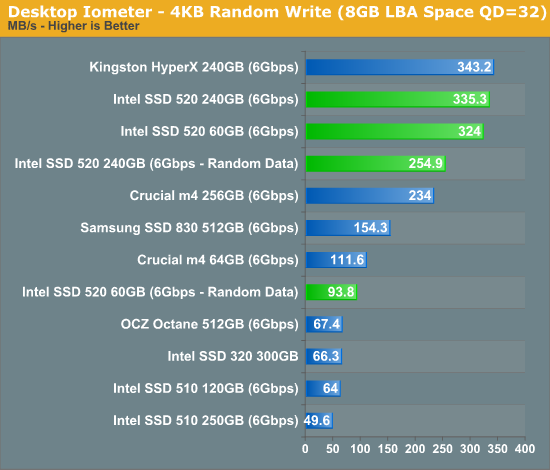
At higher queue depths the HyperX catches up to and surpassed the 520, perhaps indicating that Intel has done some work to optimize low queue depth performance on the 520 (likely what most end users will encounter).
Sequential Read/Write Speed
To measure sequential performance I ran a 1 minute long 128KB sequential test over the entire span of the drive at a queue depth of 1. The results reported are in average MB/s over the entire test length.
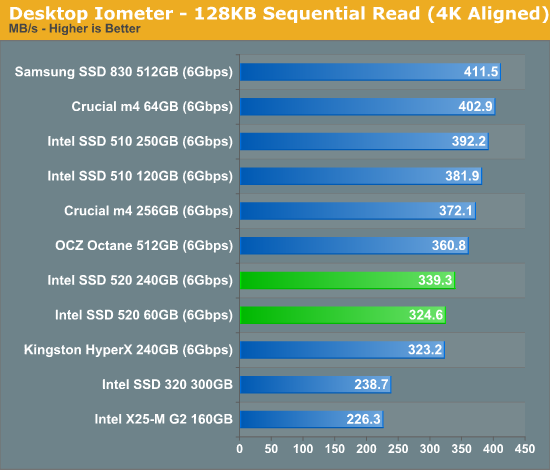
Sequential read performance is actually a bit lower than Intel's 510, but still higher than a standard SF-2281 drive.
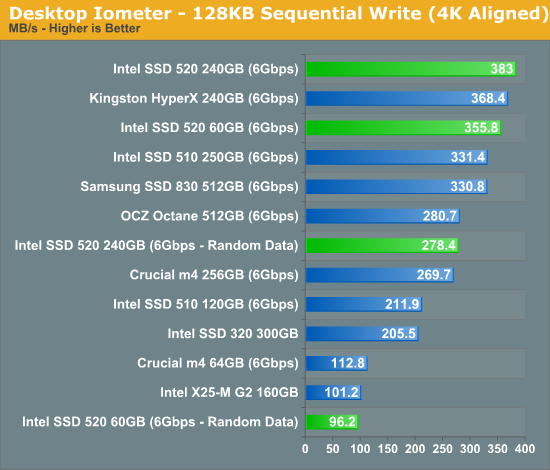
It's important to note just how close the 520's peak random write performance is to its sequential write performance. A big part of this is obviously that the SF-2281 is throwing away a lot of the data it has to write, but even if we compare incompressible 4KB random write to highly compressible 128KB sequential write we see a good ratio. The closer those two values are the more optimal the controller/firmware design is as, in theory, smaller random writes should be grouped to effectively become large sequential writes from the perspective of the NAND.










138 Comments
View All Comments
iLLz - Monday, February 6, 2012 - link
There you go, being all logical and stuff.DanSmith - Tuesday, February 7, 2012 - link
+1kyuu - Monday, February 6, 2012 - link
So, Intel wants people to pay a huge price premium over drives with identical flash and an identical controller? For what? Some validation testing and a custom firmware? Despite the fact that they source their own flash giving them a price advantage over everyone except maybe Samsung? Please.Also, the 240GB is *more* than twice as expensive as as the 120GB? Why wouldn't you just buy two 120GB drives then? I doubt the performance difference is even worth noting, and once Intel's own new RST drivers come out that support passing the TRIM command to RAID arrays comes out, you can R0 them and get *better* performance than a single 240GB.
FunBunny2 - Tuesday, February 7, 2012 - link
*NOT* identical flash or controller. Anand spent much of the text explaining that.NitroWare - Wednesday, February 8, 2012 - link
Not sure if the PCB is completely custom or Intel just put their logo on a slightly modified circuit board - and then there is the Bill of Materials for the supporting components.Corsair have been claiming publicly they went with a custom PCB for their Force 3 and even put up oscilloscope eye diagrams to 'prove' that their signal integrity as superior to a generic reference PCB
Coup27 - Monday, February 6, 2012 - link
Anand, could you please update Bench with the 830 results? They appear to have been forgotten about adding into Bench.Narrlok - Tuesday, February 7, 2012 - link
I second this request. I was about to post about this as well since I wanted to compare the 830 with this drive.beginner99 - Monday, February 6, 2012 - link
Well it seems obvious especially also because of the delay that the general advice here is to not touch OCZ and especially Sandforce seems to be more than true. There obviously must be quite a lot of bugs in the sandforce firmware.But then the price premium? I don't see it. You can get a crucial m4 that preforms just as good and has a very good track record in terms of reliability. (ignoring this 5000 hr bug...but it doubt even intel would spot that)
While it is sure a fast and reliable drive, the m4 is too while costing much less. And the Samsung isn't bad either.
eman17j - Wednesday, February 8, 2012 - link
they fixed the 5000 hr bugeman17j - Wednesday, February 8, 2012 - link
Also the newer line ocz came out with uses the Indilix controller